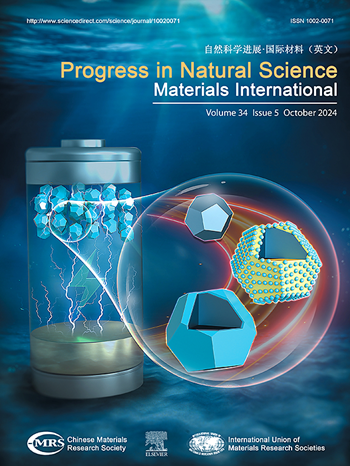The interstitial composite separators constructed by flat-engineering for high-efficiency alkaline water electrolysis
IF 7.1
2区 材料科学
Q2 MATERIALS SCIENCE, MULTIDISCIPLINARY
Progress in Natural Science: Materials International
Pub Date : 2025-08-01
DOI:10.1016/j.pnsc.2025.05.008
引用次数: 0
Abstract
Composite separators are widely used in alkaline water electrolysis due to their superior corrosion resistance. Herein, we obtained a series of separators with enhanced hydrophilicity, including a denser and smoother surface, by introducing additives and a heating treatment during the pre-evaporation process. Specifically, the interstitial strategy can be employed to address the issue of inadequate structural stability induced by conventional hydrophilic additives, such as polyvinylpyrrolidone, by utilizing TiO2 with hydrophilicity and particle size differences from ZrO2. This approach optimizes the hydrophilicity and pore size distribution, while enhancing the ductility. Z8T2 exhibits superior overall performance with an area resistance of merely 0.103 Ω·cm2, substantially outperforming the commercial Zirfon UTP500 (0.3 Ω·cm2). Using Raney Ni and NiFe-LDH as catalysts, the electrolyzer achieves a current density of 1401 mA/cm2 at 1.9 V, demonstrating a significant improvement comparing with commercial Zirfon UTP500 (1053 mA/cm2). The separator exhibits remarkable stability at a current density of 400 mA/cm2 for 300 h in 30 wt% KOH solution at 80°C and is also reused. This work provides a simple and universal strategy for process operation and additive control.

平板工程构建的高效碱水电解间隙复合分离器
复合分离器因其优异的耐腐蚀性能在碱水电解中得到广泛应用。通过在预蒸发过程中引入添加剂和加热处理,我们获得了一系列亲水性增强的分离器,包括更致密和光滑的表面。具体来说,通过利用与ZrO2具有亲水性和粒径差异的TiO2,可以采用间隙策略来解决传统的亲水添加剂(如聚乙烯吡咯烷酮)引起的结构稳定性不足的问题。这种方法优化了亲水性和孔径分布,同时提高了延展性。Z8T2具有优异的综合性能,面积电阻仅为0.103 Ω·cm2,大大优于商用锆石UTP500 (0.3 Ω·cm2)。使用Raney Ni和NiFe-LDH作为催化剂,电解槽在1.9 V下的电流密度达到1401 mA/cm2,与商用Zirfon UTP500 (1053 mA/cm2)相比有显著提高。该分离器在电流密度为400 mA/cm2时表现出显著的稳定性,在30 wt% KOH溶液中,在80°C下保持300小时,并且可以重复使用。这项工作为过程操作和附加控制提供了一种简单而通用的策略。
本文章由计算机程序翻译,如有差异,请以英文原文为准。
求助全文
约1分钟内获得全文
求助全文
来源期刊
CiteScore
8.60
自引率
2.10%
发文量
2812
审稿时长
49 days
期刊介绍:
Progress in Natural Science: Materials International provides scientists and engineers throughout the world with a central vehicle for the exchange and dissemination of basic theoretical studies and applied research of advanced materials. The emphasis is placed on original research, both analytical and experimental, which is of permanent interest to engineers and scientists, covering all aspects of new materials and technologies, such as, energy and environmental materials; advanced structural materials; advanced transportation materials, functional and electronic materials; nano-scale and amorphous materials; health and biological materials; materials modeling and simulation; materials characterization; and so on. The latest research achievements and innovative papers in basic theoretical studies and applied research of material science will be carefully selected and promptly reported. Thus, the aim of this Journal is to serve the global materials science and technology community with the latest research findings.
As a service to readers, an international bibliography of recent publications in advanced materials is published bimonthly.

 求助内容:
求助内容: 应助结果提醒方式:
应助结果提醒方式:


